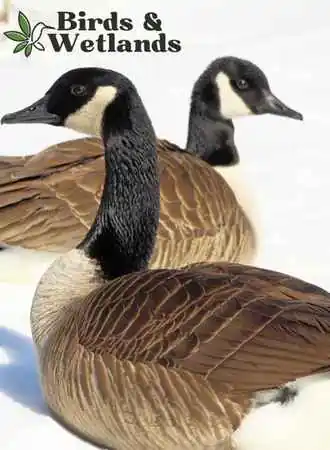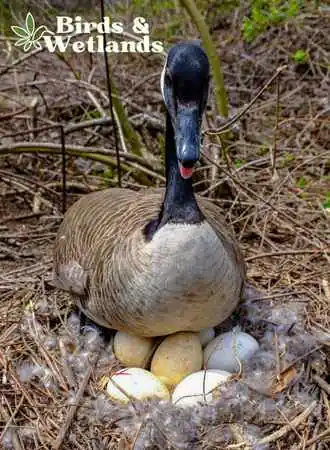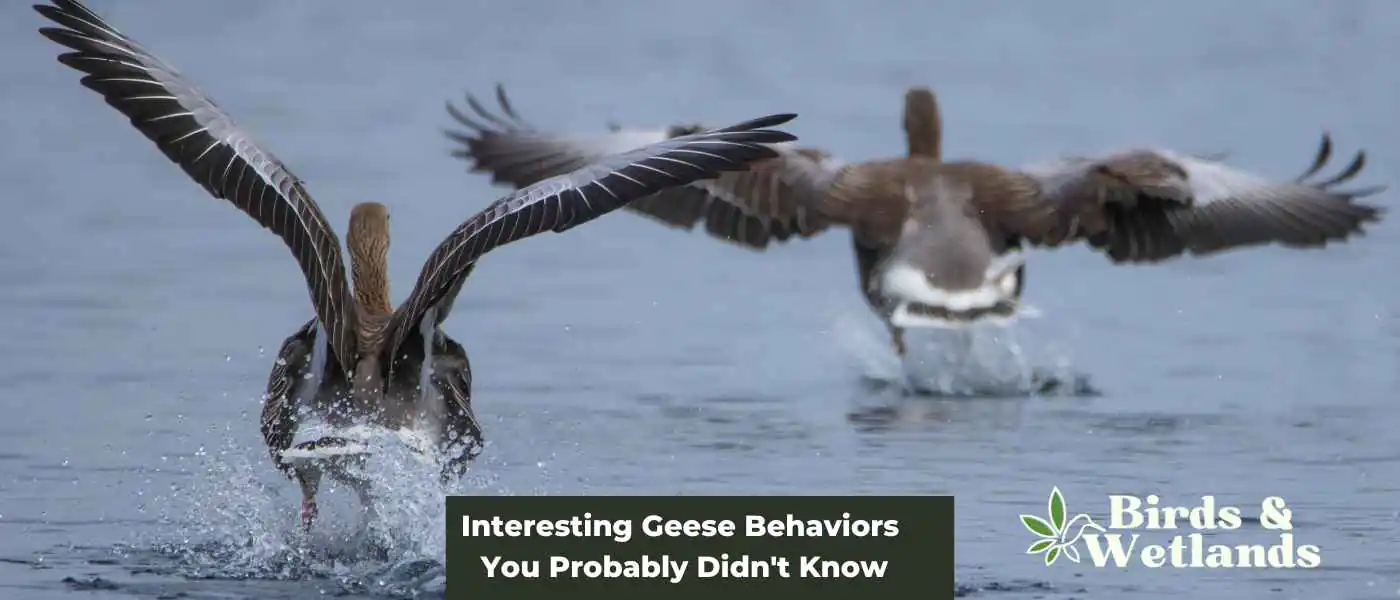Many species of geese are social animals that live in large groups and exhibit many complex behaviors. Understanding these behaviors can be beneficial to both birdwatchers and homeowners.
Observing different goose behaviors can provide insight into the birds’ social structure and daily activities for birders.
Understanding goose behavior can help homeowners avoid conflicts with these often-annoying birds.
Understanding these various behaviors allows us to appreciate these fascinating birds better.
Geese are gregarious birds that live in large flocks consisting of different family groups.
Geese exhibit many complex behaviors for mating, feeding, molting and raising their young.
Most geese spend most of their day grazing, feeding, swimming and preening.
When a goose likes you, it will nibble on your clothing, give you snuggles and goose kisses.
It is important to know when a particularly aggressive goose is about to attack to prevent further confrontation.
How do you know if a goose likes you?
There are several ways to determine whether a goose likes you. One is if they cuddle with you or rest their head on your shoulder. This is their way of claiming you as theirs and demonstrating their confidence in you.
Additionally, they may give you goose kisses. They accomplish this by tapping their beak gently on your cheek or nose. It is their method of expressing affection.
Lastly, some geese enjoy nibbling on those they like. They will nibble on your clothing or skin to demonstrate their love. Therefore, if you observe a goose engaging in these behaviors, it will likely like you.
What do geese do during the day?
Geese are sociable animals that live in large flocks. During the day, they congregate in areas with abundant grass to feed and rest. They spend the majority of their time eating and preening.
Preening helps maintain the cleanliness and health of their feathers. In addition, it helps to waterproof them, which is essential for staying warm in cold water.
Geese such as the Canadian goose and cackling goose also enjoy swimming and sunbathing. Swimming helps them maintain strong muscles and clean feathers. Sunbathing rejuvenates their bodies and dries out their feathers.
Geese return to their roosts at dusk to rest and prepare for the following day.

What are geese most afraid of?
Young and adult geese are generally afraid of noises, strong winds, and unfamiliar objects. This is why you’ll often see them skittish around tractors, pieces of machinery, and leaf blowers. To scare them away, people will sometimes use air horns or make noises that mimic their distress calls.
However, these methods only work temporarily, and the geese will eventually get used to the noise. According to the U.S. Fish and Wildlife Service, the best way to keep geese away is to make sure they don’t have a reason to stick around in the first place.
This means keeping your yard clean and free of food sources that might attract both old and young birds.
Is a Canada goose aggressive?
Most Canada geese are not aggressive by nature, but they can become aggressive if they feel threatened or their territory is being invaded. Geese are also fiercely protective of their goslings and will attack if they believe they are in danger.
While goose attacks are uncommon, they can be dangerous, so be aware of the warning signs of an aggressive goose and give them a wide berth if you come across one.
There are a few signs that a Canada goose is about to attack. The bird will first begin to make noise, usually honking or hissing. It will then lower its head and raise its wings. This is frequently accompanied by head bobbing up and down.
If you see these signs, take a step back and slowly walk away. Turning your back on the goose or fleeing may result in an attack.
Remember that Canada geese are wild animals, so exercise caution whenever you encounter them in the wild.

Can you hit a Canada goose if it attacks you?
When a goose attacks you, it is not recommended to fight back. Doing so will not only agitate the goose further, the geese might join in the fight. Furthermore, hitting, kicking, or swinging at a goose can cause harm to you or others nearby.
During a goose attack, the best course of action is to remain calm and slowly walk away from the aggressive goose. Don’t make sudden movements, and distance yourself from the goose. Until the attack subsides, attempt to make yourself as small and unattractive as possible.
How do Canada geese communicate with each other?
Canada geese use a wide variety of vocalizations to communicate. For communication over short distances, they use short, quiet grunts. The distinctive greeting call of females is a loud and prolonged snoring sound.
To communicate over long distances, they use honking calls. Using honking calls for both matched and unmatched calls allows them to signal both alarm and interest.
Geese also use body language to communicate. For instance, they will lower their head and lengthen their neck to demonstrate submission or raise their head and erect their feathers to establish dominance.
By comprehending these diverse modes of communication, we can gain a deeper understanding of the social interactions of these fascinating creatures.

Are Canada geese territorial?
Canada geese are usually very friendly birds, but they are also known for their aggressive behavior. These waterfowl can become quite territorial during the breeding season.
Suppose other animals are too close to their nest or feeding areas, the Canada goose will start honking loudly and waving its head around until the intruder goes away.
This behavior is necessary to protect the goose’s young from approaching predators. While the Canada goose is usually gentle, it is important to give them space during the nesting season.
Do Canada geese mate for life?
Canada geese are known for their close family relationships. Many people are unaware that these birds mate for life. Once the female goose has chosen her mate, the couple will form a lifelong bond.
If one member of the pair dies, the surviving pair will find another mate.
It’s also worth noting that Canada geese honk more when they’re with their mate than when they’re alone or with other geese — this is most likely a way of communicating affection.

Why do Canada geese fly in V formation?
Many Canada geese migrate every year. A large flock of Canada geese flying in a V formation is among the most distinctive sights in the sky. This formation is not just for appearances. It actually serves a purpose and is an important part of goose migration behavior.
Flying in V-formation while geese migrate south allows geese to conserve energy. The leading bird breaks the wind, making flight easier for the following birds. In addition, flying in formation makes it easier for birds to spot potential predators.
Canada geese take turns leading, rotating every few minutes, so no single bird becomes too exhausted. Flying in formation also helps family groups in remaining together.
Are giant Canada geese endangered?
The giant Canada goose is a type of the Canada goose. Its scientific name is Branta canadensis maxima. The IUCN now says that giant Canada goose populations are of “Least Concern,” but that wasn’t always the case.
In the 1950s, the giant Canada geese were already considered extinct, so no sightings of this Canada goose subspecies had been made for many years.
However, in 1962, Dr. Harold Hanson of the Illinois Natural History Survey found a small flock of wintering geese in Rochester, Minnesota, which turned out to be the extinct giant Canada geese.
After this unexpected discovery, many other small flocks of giant Canada geese have been found in other parts of their original breeding range in North America.
Thanks to various conservation efforts, the population of the giant Canada geese have bounced back. Many environmental groups are still working to protect the giant Canada geese.
Even though the giant Canada geese are no longer in danger of going extinct, it is still an important species to protect and keep alive.

Why have Canada geese settled in many urban areas?
In recent years, Canada geese have become one of the most widely-distributed North American birds. They are a common fixture in urban areas across the continental United States and Canada.
These birds have settled in many urban environments, including local parks, grain fields, retention ponds and other public areas within city limits. Additionally, golf courses suit the Canada geese’s habitat requirements.
These urban environments offer a variety of food and natural resources, such as grass, insects, and leftover human food. In addition, urban areas often have few natural predators, making them a safe place for geese to raise their young.
Urban areas often feature large open spaces, such as parks and golf courses, which provide the perfect habitat for these birds. Furthermore, these geese are known for their love for lawn grass that’s why many of them live in or near manicured lawns.
As a result of these factors, many Canada geese and other species have become well-established in many urban areas, and fewer geese are migrating every year.
This change in the migratory behavior of Canada geese have created problems for the city population. These birds leave a lot of mess, including their droppings and when geese walk across the road, they slow down traffic.
What are the different subspecies of the Canada goose?
The Canada goose has seven subspecies:
- Atlantic Canada geese (B. c. canadensis)
- Interior Canada goose (B. c. interior)
- Giant Canada geese (B. c. maxima)
- Moffitt’s Canada geese (B. c. moffitti)
- Vancouver Canada geese (B. c. fulva)
- Dusky Canada geese (B. c. occidentalis)
- Lesser Canada geese (B. c. parvipes)
Who chooses the nest site of the geese?
During spring migration, geese and other waterfowl return to their nesting grounds up north from their wintering areas.
The female chooses the nest site, which is usually near water, such as islands, muskrat houses and shorelines. She also builds the nest with plant material, and body feathers plucked from the female’s breast.
Both males and females will protect their young geese once the eggs hatch. Young geese remain with their parents and form gang broods with other young goslings from other family groups.
During the incubation period, the female incubates the eggs while the male stands nearby the nesting area.

Do adult geese molt?
Yes, adults with goslings will start molting in the brood-rearing area as their young start learning how to fly. They will regain their flight feathers back about the same time as young birds know how to fly, approximately 70 days after hatching.
Molting usually starts in late June or early July. It helps the geese regulate their body temperature. In the summer months, when temperatures are higher, molting helps to cool the goose by increasing the area of bare skin.
Molting also helps the goose get rid of damaged or worn feathers. By shedding their old feathers, geese can make way for new, healthy feathers that will help them to fly and stay warm.

